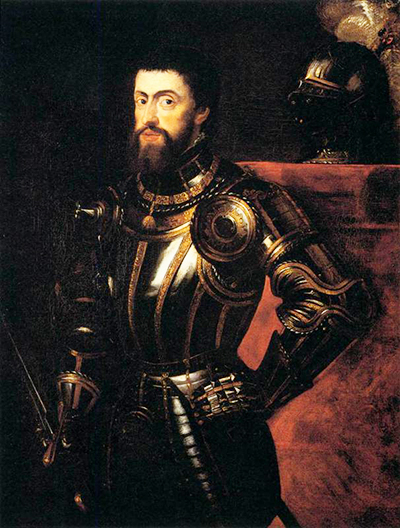Charles V in Armour, completed in 1603, is an oil-on-canvas painting by Peter Paul Rubens that portrays a Renaissance ruler who is dressed for war.
The portrait, a copy of an earlier painting by Titian that depicts the Holy Roman Emperor at the time of his coronation, measures 119 by 93 centimetres and is in private ownership. The original painting, believed to have been executed around 1530, does not survive and would have been forgotten if Rubens had not duplicated it.
This portrait of Charles V is one of thirty-three copies of Titian originals that were made by Rubens, an admirer of the Venetian master, over the course of his life. The Flemish painter had visited Venice, the home of the Titian, in order to study the sublime artworks that had been created in that important city.
Conflicts with the Kingdom of France, the Ottoman Empire and within the Holy Roman Empire itself marked the reign of Charles V while the unification of the crowns of Spain and Germany under the House of Hapsburg was achieved via peaceful means. Titian, who died before Rubens visited Venice, captured the Holy Roman Emperor at height of his powers and at the peak of his virility.
The Hapsburg ruler, visible from the waist up, brandishes an unsheathed sword while his plate armour is gilded and darkened by a black patina. An expensive suit of armour such as that shown in the painting, fashioned by the most adept craftsmen from fire-hardened steel, could only have been afforded by the wealthiest and most powerful members of society.
The drawn sword, pointing towards the heavens, may represent the earthly power that has been invested in Charles V by God and the record of the Holy Roman Emperor’s military successes would have been present in the mind of the contemporary viewer. Unification of the Holy Roman Empire and the Spanish Empire brought much of Europe, including possessions in Italy as well as the Low Countries, under the Hapsburg ruler’s command and gained him control of several colonies in the Americas.
The Siege of Vienna, in which the Ottoman Empire besieged one of the most important Imperial cities, had occurred in the year prior to the Renaissance prince’s coronation as Holy Roman Emperor. Titian’s original portrait, executed in the same year that the subject of the painting ascended to the Imperial throne, portrays the Holy Roman as a triumphant warrior who defends Christendom from the armies of Islam and Catholicism from the emerging threat of Lutheranism.




